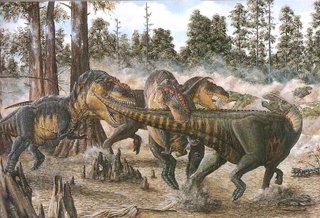It is no wonder why they avoid direct debate with serious professionals. Rarely have I seen any interaction between the two sides. It is embarrassing even for someone like me, a person of Christian faith myself. I highly suggest people read Finding Darwin's God by Kenneth Miller. I found it to be an excellent read.
All quoted material is from Creation Expeditions:
The allosaur "Ebenezer" of Creation Expeditions
Evolutionists theorize that the Edmontosaurus died millions of years ago, and some have recently speculated that this was a partially feathered type of dinosaur which eventually evolved into modern birds. The Creation Expedition team believes their discovery challenges such theories
Edmontosaurus is a hadrosaurid from the uppermost Cretaceous period of North America and is far removed from the dinosaurs thought to be the predecessors of modern day aves. No serious dinosaur paleontologist has ever considered an animal like this to bear feathery integument. Aves ( birds ) are theorized to have evolved from a clade of theropods known as the Maniraptora and are thought to have first evolved in the Jurassic. Few paleos believe feathers existed outside the larger coelurosaurian clade that contains the Maniraptora.“Buried in the same strata with Ezekiel were evidences of animals which, by evolutionary standards, should not be there, including garfish and turtles. The deposition of the animal, the fossilization and preservation of the skin, the full articulation of the animal, and the fact that it appears to be part of a fossil graveyard, all point to the relatively recent death of Ezekiel."
A clich'ed argument that can be retorted by elementary students. The statement assumes that taxa ( turtles in this case ) that had evolved before the first dinosaurs should not appear ith the dinosaur fauna. This is completely illogical. It would suggest that dinosaurs were the only existant organisms during the time of burial. Most depositional environments that preserve fossils are fluvial and contain several aqueous organisms in and of themselves. If and when a dinosaur happened to die and fall into a body of water, it would likely become deposited along with any other organism that has died in those waters.The preservation of other organisms in the same rock layer is nothing special, nor does it prove a recent burial event. It simply is a coincidental preservation of multiple contemporaries. Burial by other means ( like a mass flood ) would differ greatly and show signs in the strata. Also, pristine preservation doesn’t always necessarily mean fast burial. Some finely detailed fossils can be preserved when an organism dies in an anoxic lake bottom where little or no process of decay occurs. Lakes also cotain fine sediments and silt that preserve fine details in a fossil organism. Peat bogs are also generous preservatives.
Edmontosaurus is not known to have a crest, nor is one visibly seen on the skull obtained by the Creation Expeditions. God knows what the DeRosa and Lyndall families are looking at.
Edmontosaurus was almost certainly a consistant quadruped. If there was ever a time when Edmontosaurus walked with only its hindlegs, it would have likely been in a sprint. Also, Hadrosaurus is its own genus. The correct terminology would be hadrosaurid.
Dinosaur skin is a very rare find for paleontologists. The Sternberg family found dinosaur skin samples in 1908. This was a surprising discovery for evolutionists. In the following years, two more finds of mummified dinosaurs would be attributed to the Sternbergs. The hunt for dinosaur skin has continued, about one-tenth of one percent of all dinosaurs collected have skin. If evolution were true, how could dinosaur skin survive exposed to the elements for millions of years to the present?
 Newly found skin impression from a Montana tyrannosaur
Newly found skin impression from a Montana tyrannosaur
© 2004 BHIGR, Inc.
However, the preservation of the impressions of dinosaur skin do not act as a hinderance to the theory of evolution. As I've already brought up, it is not the actual membranous tissue that is preserved but the impressions made by that tissue. The organic material would have already rotted away, but not before it left an impression in the fine sediment that would eventually become solidified by geologic pressures.



1 comment:
EXCELLENT post.
Your music is very enjoyable, also.
Post a Comment